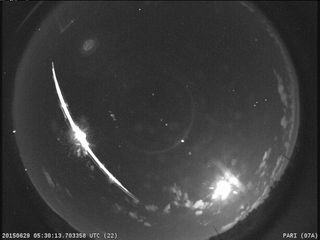
The bright light that streaked across skies throughout the American Southeast early Monday morning (June 29) was probably a piece of space junk crashing back to Earth, researchers say.
The mysterious sky light blazed up at 1:29 a.m. EDT (0529 GMT) Monday and was witnessed by skywatchers from Louisiana to Virginia — and by all six meteor-observing cameras operated by NASA in the Southeast.
But this was no meteor, said Bill Cooke, head of the Meteoroid Environment Office at NASA's Marshall Space Flight Center in Huntsville, Alabama.
"It moved too slowly," Cooke said in a video released by NASA on Monday. "This thing hit the atmosphere moving between 14,000 and 16,000 mph [22,500 to 25,750 km/h], and while that sounds fast, meteors move at 24,000 mph [39,000 km/h] or faster."
In addition, video captured by the NASA cameras reveals that the object that generated Monday morning's "shooting star" hit Earth's atmosphere at a very shallow angle, which also isn't typical for a meteor, Cooke added.
"So, the speed combined with the shallow entry angle suggest that it was a re-entering piece of space debris, or something like that," Cooke said.
The NASA cameras' footage also shows that the bright streak is actually four distinct objects moving across the sky.
Get the Space.com Newsletter
Breaking space news, the latest updates on rocket launches, skywatching events and more!
"This is typically what you see in a re-entry, where the object is breaking up, and as the pieces fall off, each one of them begins to burn up and become self-luminous," Cooke said. So it "looks like a re-entering object — something burning up in the atmosphere," he added.
Indeed, Monday morning's event may have been caused by the re-entry of Russia's SL-6 Rocket Body, which was launched in 1992 as part of the Cosmos 2196 Missile Early Warning system, Vincent Perlerin of the American Meteor Society wrote today (June 30).
Researchers are currently tracking more than 22,000 pieces of debris at least 4 inches (10 centimeters) wide in Earth orbit, and millions more that are too small to spot with current technology are probably zipping around the planet.
Follow Mike Wall on Twitter @michaeldwall and Google+. Follow us @Spacedotcom, Facebook or Google+. Originally published on Space.com.
Join our Space Forums to keep talking space on the latest missions, night sky and more! And if you have a news tip, correction or comment, let us know at: community@space.com.

Michael Wall is a Senior Space Writer with Space.com and joined the team in 2010. He primarily covers exoplanets, spaceflight and military space, but has been known to dabble in the space art beat. His book about the search for alien life, "Out There," was published on Nov. 13, 2018. Before becoming a science writer, Michael worked as a herpetologist and wildlife biologist. He has a Ph.D. in evolutionary biology from the University of Sydney, Australia, a bachelor's degree from the University of Arizona, and a graduate certificate in science writing from the University of California, Santa Cruz. To find out what his latest project is, you can follow Michael on Twitter.
